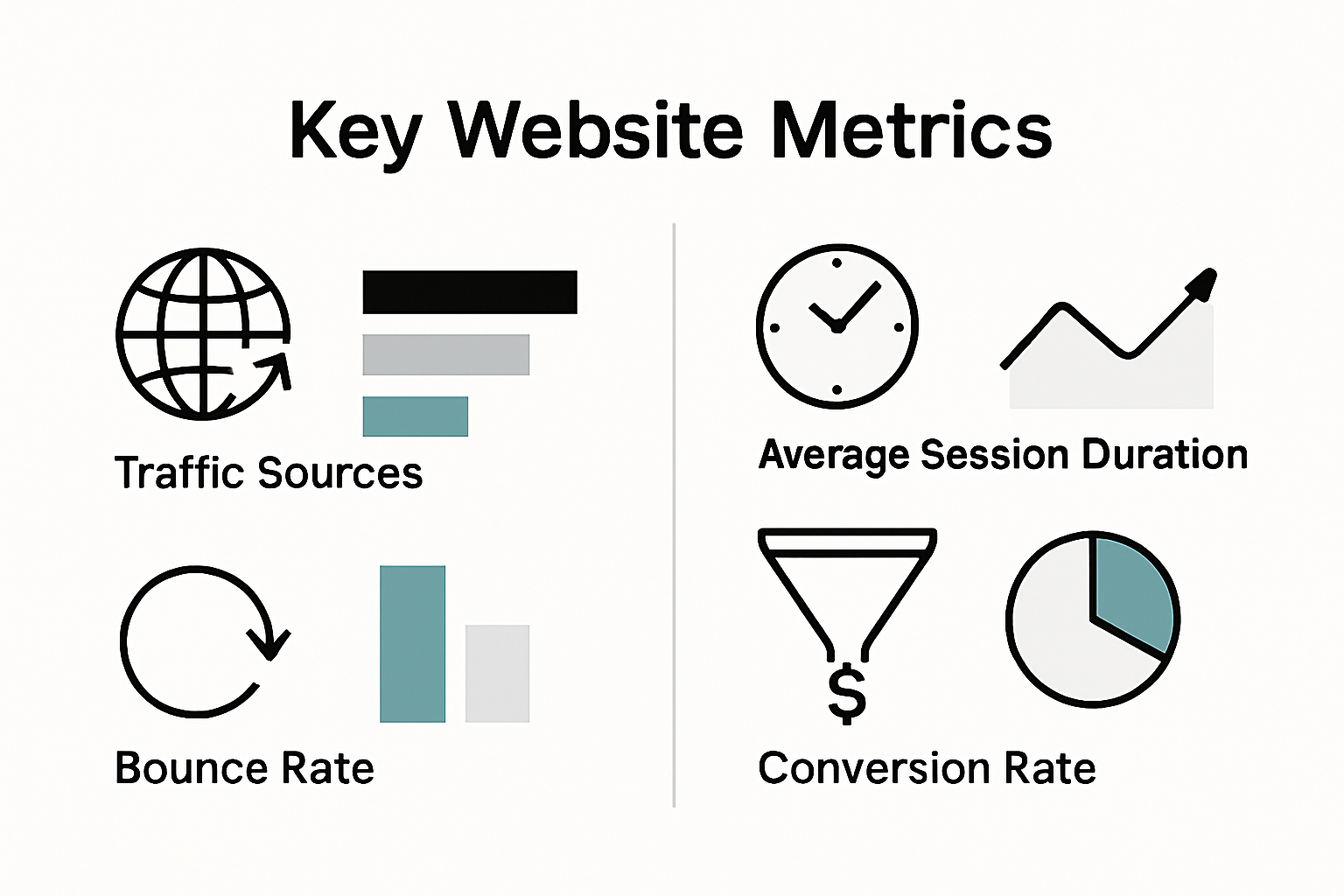Top Strategies for Website Growth in 2025: Boost Traffic & Results


Everyone wants their website to stand out in 2025, but there is more to growth than piling up clicks and pageviews. Numbers alone can be misleading. A single second of slow load time can slash conversions by 7 percent. Surprised? Most people obsess over traffic spikes, when the real power comes from the right mix of engagement, technical excellence, and smarter connections. The shift is bigger than it looks.
Table of Contents
- Understanding Key Metrics For Website Growth
- Optimizing Seo And Content For Higher Visibility
- Leveraging Social Media And Email Marketing
- Building Authority Through Backlinks And Partnerships
Quick Summary
| Takeaway | Explanation |
|---|---|
| Focus on Quality Traffic | Aim for organic traffic to attract valuable audiences. High engagement rates lead to better search rankings. |
| Optimize for Conversion Rates | Implement continuous testing to enhance user experiences and increase the conversion percentage. Small changes can result in significant boosts. |
| Emphasize Technical Performance | Monitor key technical metrics such as load speed and mobile responsiveness. Improving these factors is essential for user satisfaction and SEO. |
| Leverage Social Media Engagement | Build authentic interactions on social platforms rather than just posting promotions. Foster community and share valuable insights to engage users effectively. |
| Acquire High-Quality Backlinks | Focus on obtaining endorsements from reputable sites within your industry. Quality backlinks significantly enhance credibility and improve search rankings. |
Understanding Key Metrics for Website Growth
Website growth requires a strategic approach to measuring performance through critical metrics that reveal true online success. Digital marketers and business owners must move beyond surface level analytics to understand how their websites genuinely engage and convert audiences.
Traffic Volume and Quality Analysis

Measuring website growth starts with understanding traffic dynamics. Raw visitor numbers tell only part of the story. Organic traffic represents the most valuable metric, indicating how effectively your content attracts users through search engines. Google Analytics provides comprehensive insights into traffic sources, revealing whether visitors arrive through search, social media, direct links, or referral channels.
Quality metrics matter more than quantity. A Backlinko study revealed that websites with higher engagement rates and lower bounce rates tend to rank better in search results. This means attracting the right audience who finds genuine value in your content becomes more critical than simply increasing visitor numbers.
Conversion Rate and User Engagement
Conversion rates represent the ultimate measure of website effectiveness. These metrics demonstrate how successfully your site transforms casual visitors into customers or leads. Key indicators include:
- Conversion Percentage: Total number of visitors completing a desired action
- Average Session Duration: Time users spend exploring your website
- Page Views per Session: Depth of user interaction with your content
Professional marketers understand that conversion optimization requires continuous testing and refinement. Small improvements in user experience can dramatically increase conversion rates. For instance, Unbounce research suggests that strategic landing page design can boost conversions by up to 30%.
Performance and Technical Health Metrics
Beyond user interactions, technical performance significantly impacts website growth. Search engines prioritize websites with superior technical infrastructure. Critical metrics include:
- Page load speed
- Mobile responsiveness
- Security protocols
- Server uptime
Technical performance directly influences user experience and search engine rankings. A one-second delay in page load time can reduce conversions by 7%. Website owners must continuously monitor and optimize these technical aspects to maintain competitive digital presence.
Strategies for website growth demand a holistic approach. By understanding and strategically improving these key metrics, businesses can create more engaging, effective online platforms that attract, retain, and convert valuable audiences.
Here is a table summarizing the key website metrics and their impacts, as discussed above:
| Metric | Description | Impact on Growth |
|---|---|---|
| Organic Traffic | Users arriving via search | Indicates content and SEO quality |
| Engagement Rate | Percentage of active, involved users | Higher rates boost rankings |
| Bounce Rate | % of users leaving after one page | Lower rates signal relevant content |
| Conversion Percentage | % completing desired actions | Directly measures effectiveness |
| Average Session Duration | Time spent per visit | Longer sessions signal engagement |
| Page Load Speed | Website load time | Every second delay can cut conversions by 7% |
| Mobile Responsiveness | Adaptability to mobile devices | Required for user satisfaction |
| Security Protocols | HTTPS and data protection | Boosts credibility and SEO |
Optimizing SEO and Content for Higher Visibility
Searching for effective strategies to boost online visibility requires a comprehensive approach that goes beyond traditional keyword optimization. Modern SEO demands a sophisticated blend of technical expertise, content quality, and strategic thinking.
Developing Authoritative Content Experiences
Content optimization starts with creating comprehensive resources that demonstrate genuine expertise. Search Engine Land recommends developing cornerstone content that serves as a foundational pillar for your website's topical authority. This means crafting in-depth articles that comprehensively address user questions and provide unique insights.
The key is to map out content that creates a holistic understanding of your subject matter. Topical depth matters more than keyword density. Website owners should focus on creating interconnected content that explores various aspects of a topic, establishing themselves as true experts in their field.
Technical SEO and User Experience Optimization
Search engines prioritize websites that deliver exceptional user experiences. The U.S. Department of Energy highlights the critical importance of technical elements in search visibility. This includes:
- Crafting unique and descriptive page titles
- Developing concise, informative page summaries
- Structuring content with clear, hierarchical headings
- Implementing natural keyword integration
Mobile optimization has become non-negotiable. HigherVisibility emphasizes that mobile devices now account for a significant portion of organic search visits. Websites must ensure responsive design, rapid page loading, and intuitive navigation to meet modern user expectations.
Strategic Content Gap Analysis
Successful SEO requires continuous improvement through systematic content analysis. Professional marketers should regularly conduct content gap analyses to identify missing topics and emerging user needs. This proactive approach allows websites to:
- Discover unexplored subject areas
- Address specific user questions
- Create targeted content that fills information gaps
The goal is to build a comprehensive content ecosystem that demonstrates E-E-A-T principles - Experience, Expertise, Authoritativeness, and Trustworthiness. By consistently producing high-quality, relevant content that genuinely serves user needs, websites can significantly improve their search engine visibility and audience engagement.
Strategies for website growth are not static. They require ongoing refinement, deep understanding of user intent, and a commitment to delivering exceptional value through every piece of content.
To help clarify the main tactics for SEO and content optimization mentioned, here's a table summarizing each approach and its core benefits:
| SEO & Content Strategy | Main Focus | Primary Benefit |
|---|---|---|
| Cornerstone/Authoritative Content | In-depth, comprehensive resources | Boosts topical authority |
| Technical SEO (Titles, Headings, Keywords) | Structured, user-focused site architecture | Enhances search visibility |
| Mobile Optimization | Responsive and fast mobile experience | Improves user experience & SEO |
| Content Gap Analysis | Identifying and filling missing topics | Addresses user needs |
| E-E-A-T Principles | Demonstrates expertise, authority, trust | Strengthens Google rankings |
Leveraging Social Media and Email Marketing
Digital marketing success hinges on creating strategic connections with audiences through sophisticated social media and email marketing approaches. These channels offer powerful opportunities to expand website visibility, engage potential customers, and drive meaningful interactions.
Strategic Social Media Engagement
Social media platforms are not just broadcasting tools but sophisticated engagement ecosystems. Successful digital marketers understand that authentic interaction trumps pure promotional content. Platforms like LinkedIn, Twitter, and Instagram provide unique opportunities to showcase brand personality, share valuable insights, and create community around your digital presence.
Effective social media strategies require more than sporadic posting. Businesses must develop consistent content calendars, create platform-specific content, and understand each platform's unique audience dynamics. Hootsuite's Social Media Trend Report suggests that platforms rewarding genuine, educational content see higher engagement rates compared to purely promotional approaches.
Email Marketing Precision
Email marketing remains a cornerstone of digital communication strategies. The National Institutes of Health research highlights email campaigns as critical tools for driving website visits and maintaining audience connections. Successful email marketing goes beyond generic newsletters, focusing instead on:
- Segmented Audience Targeting: Delivering personalized content based on user interests
- Automated Engagement Sequences: Creating strategic email workflows
- Value-Driven Communication: Providing actionable insights rather than pure sales pitches
Modern email marketing leverages advanced analytics to track open rates, click-through percentages, and conversion metrics. This data-driven approach allows continuous refinement of communication strategies.
Cross-Platform Content Synchronization
The most effective digital marketing strategies create seamless experiences across different platforms. This means developing content that can be easily adapted and shared between social media channels, email campaigns, and website resources. Successful cross-platform strategies involve:
- Creating modular content that can be repurposed
- Maintaining consistent brand messaging
- Using analytics to understand audience preferences
- Developing interconnected content ecosystems
By treating social media and email not as isolated channels but as integrated components of a comprehensive digital strategy, businesses can create more compelling, cohesive audience experiences. The goal is not just to broadcast messages but to build meaningful digital relationships that drive website growth and customer engagement.
Strategies for website growth require continuous adaptation, understanding emerging digital communication trends, and maintaining a genuine commitment to providing value to your audience.
Building Authority Through Backlinks and Partnerships
Building digital authority requires a strategic approach to developing high-quality backlinks and establishing meaningful professional partnerships. These connections serve as critical signals of credibility and expertise in the complex digital ecosystem.
Strategic Backlink Acquisition
Backlinks represent more than simple website connections. They are powerful endorsements that search engines use to evaluate website credibility. A comprehensive study revealed that the number and quality of backlinks directly impact website ranking performance.
Successful backlink strategies go beyond quantity. Quality trumps volume. Professional marketers focus on obtaining links from authoritative domains with relevant, contextual connections. This means targeting websites with established reputations in your specific industry or related professional domains.
Effective techniques for acquiring high-quality backlinks include:
- Creating exceptional, shareable content
- Participating in industry discussions
- Offering expert insights to reputable publications
- Developing comprehensive research resources
Collaborative Partnership Development

Professional partnerships can include:
- Joint research projects
- Collaborative content creation
- Cross-platform knowledge sharing
- Alumni network engagement
These collaborative efforts create natural, high-value backlink opportunities while simultaneously expanding professional networks and demonstrating organizational expertise.
Advanced Backlink Acquisition Techniques
Specialized SEO research suggests sophisticated methods for obtaining authoritative backlinks. Key strategies include:- Conducting comprehensive competitor backlink analysis
- Identifying gap opportunities in existing content
- Creating specialized, industry-specific resources
- Targeting high-authority domains like .edu and .gov websites
Successful backlink strategies require continuous monitoring and adaptation. Website owners must regularly audit their backlink profiles, removing low-quality links and identifying new partnership opportunities.
Strategies for website growth demand a proactive approach to building digital authority. By developing genuine, value-driven partnerships and creating exceptional content, businesses can establish themselves as trusted resources in their professional domains.
Frequently Asked Questions
What are the most important metrics to consider for website growth in 2025?
Key metrics include organic traffic, engagement rates, conversion percentages, average session duration, and technical performance factors like page load speed and mobile responsiveness.
How can I optimize my website for better conversion rates?
Optimizing your website for conversion rates involves continuous testing of user experiences, refining landing page designs, and implementing changes based on user behavior analytics.
What role does technical SEO play in website growth?
Technical SEO is crucial for enhancing website performance and user experience. It involves optimizing site structure, improving loading speeds, and ensuring mobile responsiveness, all of which positively impact search rankings.
How can social media and email marketing enhance website traffic?
Social media and email marketing can enhance website traffic by fostering authentic engagement, sharing valuable content, and reaching targeted audiences through personalized communication and consistent outreach.
Ready to Unlock Real Website Growth?
Are you tired of seeing your traffic numbers rise but conversions and real business results stay flat? If the challenges highlighted in our strategies article sound familiar—slow load speeds, weak engagement, or lack of quality content—now is the time to take control. Imagine having AI-driven content that attracts the right audience, boosts engagement, and helps you rise above your competition automatically.

Let BabyLoveGrowth.ai do the heavy lifting for you. With an easy three-step process that covers business and competition analysis, a custom 30-day content plan, and fully automated SEO content generation, you stay focused on your business while your site climbs the rankings. Act today and experience effortless website growth that truly delivers. Visit BabyLoveGrowth.ai now and transform your website’s future.
Smart SEO,
Faster Growth!
Most Read Articles

Generative Engine Optimization (GEO)
Learn how Generative Engine Optimization (GEO) helps your content rank in AI search engines like ChatGPT and Google AI. This comprehensive guide explains the differences between SEO and GEO, why it matters for your business, and practical steps to implement GEO strategies for better visibility in AI-generated responses.

Track LLM Traffic in Google Analytics 4 (GA4)
Learn how to track and analyze traffic from AI sources like ChatGPT, Claude, Perplexity, and Google Gemini in Google Analytics 4. This step-by-step guide shows you how to set up custom filters to monitor AI-driven traffic and make data-driven decisions for your content strategy.

How to Humanize AI Text with Instructions
Learn practical techniques to make AI-generated content sound more natural and human. This guide covers active voice, direct addressing, concise writing, and other proven strategies to transform robotic text into engaging content.

Open AI Revenue and Statistics (2024)
Comprehensive analysis of OpenAI financial performance, user engagement, and market position in 2023. Discover key statistics including $20B valuation, $1B projected revenue, and 100M+ monthly active users.